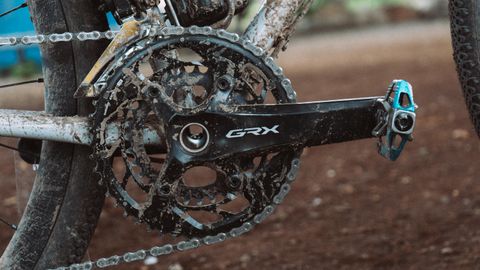Cyclingnews Verdict
The most road-like of all the gravel groupsets nowadays, but beyond that GRX 12sp is about as good as it gets in terms of gear range, shifting, and braking unless you pay significantly more for RED XPLR AXS.
Pros
- +
Greatly improved braking
- +
Useful shifter customisation
- +
Segment leading gear range
- +
Brilliant shifter ergonomics
Cons
- -
Harder to setup than SRAM options
- -
Not wireless
You can trust Cyclingnews
The previous iteration of Shimano GRX, the 11sp Di2 version, was my first foray into electronic gears. I ran it constantly on my long term gravel test bike, a Fairlight Secan, and it must be said it never skipped a beat. Roll on a handful of years since joining Cyclingnews and electronic shifting has continued to mature and trickle down. We now have electronic Shimano 105, though it isn’t exactly the performance groupset for the everyperson anymore thanks to a much higher price tag than the cabled version that runs in parallel.
While SRAM has electrified more or less all of its groupset options, and has binned off the front derailleur entirely, Shimano is staunchly continuing to offer 2x for its gravel lines. I swapped it out like for like with the old 11sp groupset and have been bashing it about both on and off-road, plus a bit of commuting besides, over the last few months.
The short version, if you are particularly impatient, is that I love it. It’d be a stretch to say the changes from the 11sp to 12sp products are earth-shattering, but there are noticeable improvements that bring what was my favourite gravel groupset bang up to date with the competitors, which had begun to make the 11sp setup feel a little dated. Given it’s what will be fitted to many of the best gravel bikes on the market going forward, it is heartening to know that in this regard at least they haven’t been short-changed on the spec front.
As with any product that aims to be greater than the sum of its parts, I’ll run you through each component in turn, including the imaginatively titled ‘GRX Tubeless Carbon Wheel’. If you want a primer, with all the key updates, then my news article on the release of the new GRX is a great place to start, but I’ll go into each of the changes below as and when they become relevant.
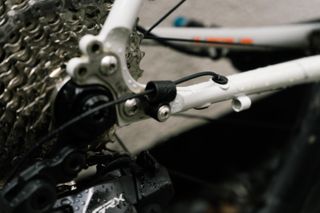
Initial setup
There is, I’m afraid, no getting around the fact that setting up a Shimano electronic groupset, whether it’s 105, Dura-Ace, or GRX, is more of a pain in the arse than any SRAM equivalent. Not having to thread wires through anywhere is a big plus for the American option, but having the hoods wireless to the derailleurs does at least make it one-notch less annoying.
It’s fiddly, but not rocket science to get everything set up. If you’re a relatively competent home mechanic you’ll be absolutely fine, and if you aren't then I suggest you find someone who is, or pay a professional. Installing everything with the correct torque is the easy bit. Threading the wires from battery to front and rear derailleur is the hard bit, though it’s no harder than threading internal derailleur cables used to be before the flow of electrons confined them to the scrapheap.
Somewhere in the middle in terms of difficulty is pairing everything together. I did find that my phone struggled to find the Bluetooth signal of the rear derailleur (the master unit in this case), but this was remedied by deleting all the old, superfluous Bluetooth connections saved in my phone's memory. Goodbye hire cars and once-used party speakers, hello E-Tube.



Once your phone has found the rear derailleur it’s dead easy to pair everything. Each lever has a QR code etched on the inside of the shifter paddles, though it took a bit of additional torchlight for my phone to scan it happily. Once it did, everything sang from the same hymn sheet.
I shan’t bore you with exactly how to set up the gears, as it is identical to the system for the other Shimano groupsets and not hugely interesting, but it is pretty simple. Set aside half an hour or so to really dial it in and you’ll be absolutely fine. You can, at this point, also re-assign the buttons to do other things, but I’m going to address that shortly when we get to the levers.
One thing that’s really key to know for a small handful of you is that as the battery is (generally speaking) going up the inside of your seatpost, you can’t necessarily run the full suite of aftermarket seatpost options. Many, or even most dropper posts and suspension seatposts like the Redshift ShockStop won’t accept a battery inside them and you have to get creative to make it work with unofficial means.

Aesthetics
Apologies to any fashionistas, but this section will be relatively brief. There’s no great departure in terms of aesthetics from the old model. The rear derailleur is infilled and looks a little sleeker in my opinion, and the chainrings and front derailleur have a few more holes in them, but that’s basically it. If I had witnessed a Shimano gravel groupset commit a crime from across the street and was presented with the 11sp and 12sp versions in a lineup I don’t think I could in good conscience send either of them to the slammer.




The hoods
The 11sp hoods were excellent, and happily not much has changed. The shape is my favourite of all the current hoods I’ve tried. The pommel is almost hooked backwards on itself on both iterations, which really aids in locking your hands in when the going gets rough. The ribbing is basically the same on top, though the ribs on this version are narrower and more numerous, and the textured underside has gone in favour of some additional ribs on the inside where your fingertips rest.
What has changed, though it’s hard to tell without putting the old and new levers back to back, is the length. The 11sp GRX levers were already among the most reachy out there, and the 12sp versions are even longer. Fortunately, though, this extra length is all fore of the hand area, and I presume it is to make room for new internals for the Servo Wave brakes, which I’ll touch on shortly.
Ergonomically they’re excellent, even on the roughest terrain they offer a stable, comfortable position. They are optimised for flared bars, though I am not really partial to a flare. Regardless, I do run them turned in slightly anyway with no ill effects.
With the time period of this test, it’s not really possible to ascertain the usefulness of the LED indicator light in the shifters, which tells you when the coin cell battery in them is running flat, but I can’t see any reason it isn’t a good addition and a helpful upgrade.
The thumb button remains, but it is this time a prominent button, rather than a button existing beneath a recessed slot. I did like the ergonomics of the old style, though it meant you had to press it with your thumb joint rather than the thumb pad. On the 12sp it’s just a touch easier, though a little less sleek visually.
Those thumb buttons aren’t just for show, you can program them to do whatever you want (within reason). They won’t do your tax return or tell you you aren’t actually going grey, but they can be setup to do the job of the main shifter paddles as extra buttons, or other more useful things as I found out when I built in some computer integration.




The thumb buttons I found were most useful when setup to control my Wahoo Elemnt Bolt bike computer. The thumbs can be set to do the job of the main buttons on the base of the computer with a short press, and of the side buttons with a long press. Given the recent integration of music controls into Wahoo bike computers I found it is possible to skip tracks and adjust the volume of my music all from my hoods. It really did feel like a bit of a step into the future. While I haven’t tested it, given that you can now control a GoPro from your Wahoo the same must be true of now being able to control a GoPro via the shifter hoods. Magic, basically.
It's worth remembering that this isn't a Wahoo feature, and you can control certain aspects of some Garmin computers, but crucially you can't do it with a Hammerhead computer since SRAM owns Hammerhead now and the two systems no longer play nicely together.
The other application I can see for the thumb buttons is for setting them up as in-built satellite shifters. When really laying the power down over rough ground they are more easily reached than the paddles, but given that I don't race I found the computer integration more key to my interests of flicking through emo tunes from the 2000's.
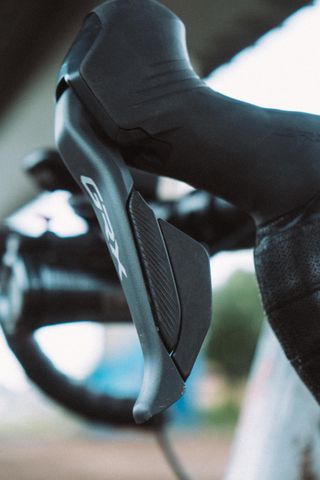
Thumb buttons aside, an update for this latest GRX is ‘Front Shift Next’. This is an option whereby one button can be programmed to shift the front derailleur both up and down, whichever position it isn’t currently in. I tried setting my shifters up like SRAM, with one inner paddle doing the front derailleur, but in the end I settled on what I think is the ideal system. The right shifter paddles behave as normal, but I assigned both left paddles as ‘Front Shift Next’ meaning whichever one of them I slapped I still shifted the front derailleur. No more tapping the wrong button when your brain is oxygen deprived as you try and shift into the big ring quickly after a climb, just press any fingers in the general direction of the paddles and you’re golden.
So enamoured am I with the GRX hoods that I think given the choice I’d fit them to my road bikes too. It’s not really the done thing but these hoods are compatible with 12sp 105, Ultegra, and Dura-Ace brakes and derailleurs. This is in part thanks to GRX 12sp coming with Servowave braking, in line with the current road groupsets.


The brakes
Here’s where I think the greatest improvements have been made. Forget extra sprockets, when you’re riding off road, at speed, powerful, well modulated brakes make as much difference as anything else.
The basics of Servowave are that the pads start 10% wider than before, with more of the pad movement taken up in the early part of the stroke. This negates the extra gap initially, and then in the latter part of the lever stroke, each millimetre of lever movement equates to less pad movement, and therefore more modulation.
Basically, the brakes are noticeably better. The feel is better, they’re not overpowered at all as I found with the Hope RX4+ brakes, and as well as improvements in modulation the additional pad gap has even more uses for gravel than it does on the road.
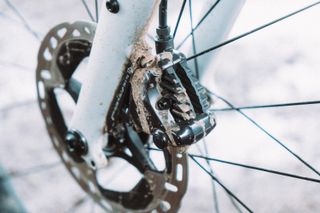
I spent less time with these brakes with my pads rubbing on some grime in my callipers after a muddy section than I did on the old brakes. It still happens, but it’s rarer, and stops sooner. What’s more, if you have been sold the ‘two wheelsets on one bike’ dream then you’re going to have less hassle re-centring your callipers as there’s a greater margin for error. I have swapped between a few wheelsets here and it’s been pretty much plain sailing. It’d be naive to suggest you’ll never have to re-centre, but it's an improvement nonetheless.
The brakes are great, but if braking is your raison d’être then they still aren’t quite up to the amazing feel of Campagnolo brakes, which I believe are manufactured by Magura.



Shifting and gears
The shifting is pretty much faultless. The one real selling point to GRX, or any electronic shifting for that matter, is its dogged determination to keep on shifting crisply and reliably even when absolutely caked in muck. I will continue to test this through the winter, but so far it’s been as reliable as the old 11sp.
I can’t say I have noticed an improvement in shifting necessarily, but having Front Shift Next setup is certainly an implement in the system rather than the shift themselves. The shifts, particularly at the front, aren’t quite as instantaneous as those of Dura-Ace (GRX isn’t pitched at that level so it’s no great surprise), but I found GRX performs better in those high torque, low cadence situations that you come across far more often off-road.
I did have a little more trouble with chain rub at the very extremes of cross chaining here but that’s a setup issue rather than a problem with the groupset itself. As with the old 11sp and all other Di2 systems the front derailleur naturally trims depending on where you are on the cassette.
One thing GRX in its 2x guise has over any SRAM option is gear range. Yes, the Red axs XPLR cassettes are monumental with their 10-46 tooth range, but in terms of actual gear inches a 2x GRX groupset nets you 24-121 gear inches, while Red XPLR with a 42t chainring is a spread of 25-116. With 2x you can climb steeper and spin out less frequently, and the cassettes are cheaper too. This is a hill I am willing to die on.




My gravel riding, because I don’t live in a gravelly fairyland, involves quite a lot of road riding. In the big ring GRX feels like a road groupset. Ignoring for a second the moderately smaller chainring sizes, it’s actually a very good road groupset, and if you’re either riding a lot of road between gravel sections, or you are riding your gravel bike as a road bike with a wheel swap as many people do than I really think GRX gives you the upper hand here.
Given it’s at least powertrain based, you don’t have any power meter options. SRAM does do a wonderful job of including them in its offerings, ignoring any discussions about non-replaceable chainrings for a second, but as my colleague Josh says often in discussions like this “yes, not having a power meter is annoying, but it’d be more annoying to have to pay for a power meter and not want it”.




The wheels
Perhaps not always tackled about, but Shimano’s groupsets, particularly at the higher end, have equivalent wheelsets. The GRX wheels, catchily titled ‘Tubeless Carbon Wheel’, are tubeless, carbon (and yes, wheels), with a rim depth of 32mm and a 25mm internal rim width. They’re certainly not crazy progressive like the latest Zipp 303 XPLR SW that my colleague Tom recently reviewed, but they are to my mind a great under the radar option.
As well as testing them out on my long termer, I also rode a set that were fitted to the latest edition of the Genesis Croix de Fer. Unfussy is how I’d sum them up. They lacked that hyperlight, overly stiff feel of some more race oriented wheels, and I think using traditional steel spokes here is helping in that regard. Comfortable and reliable, with a lovely direct hub engagement from a mercifully quiet ratchet system rather than pawls.
The bearings are traditional cup and cones, as is the way with high end Shimano wheels, but they came out of the box perfectly loaded with no play and a buttery smoothness. Bearing resistance generally speaking is basically next to nothing, as long as everything isn’t rough, and while it may seem slightly old fashioned to have cup and cones the home mechanic in me is happy, and they’ll be more readily field serviceable in a pinch.
With the way tyres are going nowadays, a 25mm internal width may be a little on the narrow side, but as they’ll happily accept 32-50c tyres that is, for now at least, the capacity of more or less every gravel bike on the market covered. With a price tag of around £1,200 / $1,600 they’ve got great upgrade potential, in the same sort of ballpark as the Hunt 40 Carbon Gravel Race.
I am not going to include the wheels as part of the scorecard below. I have included what I think of them as they were sent to me with the groupset, but in reality 99% of consumers are probably either buying just the wheels or just the groupset.


Measured weights
| Component | Weight (grams) |
| Front derailleur | 138.3 |
| Rear derailleur | 309.7 |
| Shifter (single) | 219.7 |
| Caliper & hose | 151.7 |
| Crankset | 704.2 |
| Battery | 52.5 |
| Rotor (single) | 106.9 |
| Cassette | 318.9 |
| Chain | 279.2 |
| Front wheel with valve | 720 |
| Rear wheel with valve | 840 |
Value
To start with let’s compare GRX to its in-house siblings. It is priced at Ultegra level (£2,060 / $2,700 - though in the USA it isn't available as a full groupset, just the sum of parts) and to my mind it offers similar performance. It’s a step up from 105, with the added shifter buttons for a start, so so far, so good. Most of you aren’t considering whether to buy GRX or Ultegra though, so how does it compare to SRAM. Given that Ekar isn’t electronic it makes comparison in this regard a little more cumbersome.
It is a step below the latest SRAM Red XPLR AXS, but for a nominally Ultegra-level setup, this isn’t a huge surprise. Compared to Force XPLR AXS, which is priced similarly, it’s an easier comparison.
I don’t think either is necessarily better - I personally prefer Shimano, though - but each has its strengths. Force is easier to set up, with easier battery admin and is totally wireless. The Shifting on GRX is better, as are the hood ergonomics, but there is no power meter option. Pick your poison, but neither it nor Force are a rip off. Ultimately the latest 12sp GRX is a high quality product and is priced accordingly.
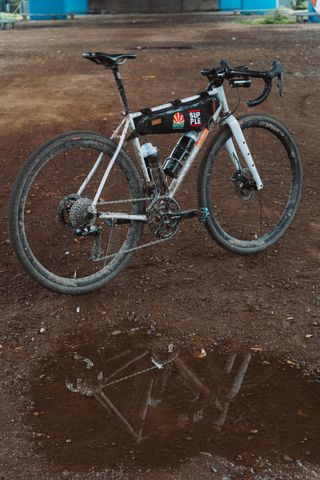
Verdict
At a high level it’s easy to plonk 12sp GRX into a box labelled “gravel groupset for roadies”. If you are a roadie, and your gravel riding is fast and you value consistency between your bikes then I really do think this is the right option for you. This latest GRX is more than that, though. It’s strength is in its versatility. You could happily fit this setup to an all-road bike and never touch gravel in your life and not be held back in any way. Even winter bikes too, and riders who don’t want the harder gearing on offer from road groupsets, can benefit.
If 1X is your thing then SRAM does dominate that market, and I haven’t tested a 1x setup of this groupset, but I’m a staunch 2x believer and I think perhaps only the latest RED XPLR AXS will move my needle more towards 1x.
Among its competitors at the same price point, this GRX groupset has the beating of them in terms of shifting, gear range, ergonomics, and braking. It’s more of a pain to set up, and there are some limitations in terms of battery placement, but unless you’re getting extremely rad and basically want an MTB-lite setup I think this is more or less the pinnacle of gravelly groupsets alongside the latest Red.
| Attributes | Notes | Rating |
|---|---|---|
| Weight | On a par with similarly priced competitors. Shifters and derailleurs are lighter, but you have to add the internal battery. | 8/10 |
| Ergonomics | Basically perfect as far as shifter hoods go. | 10/10 |
| Brakes | Much improved, and about as good as gravel bike brakes get. | 10/10 |
| Shifting and gear range | Deals with high torque well, crisper shifts than Force, and better gear range than any other option | 10/10 |
| Value | It ain't cheap, but it's offering similar performance to Ultegra for a similar price, and I think you get more for your money than with Force as long as you don't want an included power meter. | 8/10 |
| Overall | Row 5 - Cell 1 | 92% |

Thank you for reading 5 articles in the past 30 days*
Join now for unlimited access
Enjoy your first month for just £1 / $1 / €1
*Read any 5 articles for free in each 30-day period, this automatically resets
After your trial you will be billed £4.99 $7.99 €5.99 per month, cancel anytime. Or sign up for one year for just £49 $79 €59

Join now for unlimited access
Try your first month for just £1 / $1 / €1

Will joined the Cyclingnews team as a reviews writer in 2022, having previously written for Cyclist, BikeRadar and Advntr. He’s tried his hand at most cycling disciplines, from the standard mix of road, gravel, and mountain bike, to the more unusual like bike polo and tracklocross. He’s made his own bike frames, covered tech news from the biggest races on the planet, and published countless premium galleries thanks to his excellent photographic eye. Also, given he doesn’t ever ride indoors he’s become a real expert on foul-weather riding gear. His collection of bikes is a real smorgasbord, with everything from vintage-style steel tourers through to superlight flat bar hill climb machines.
